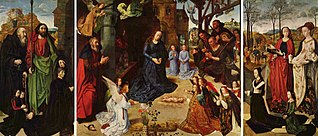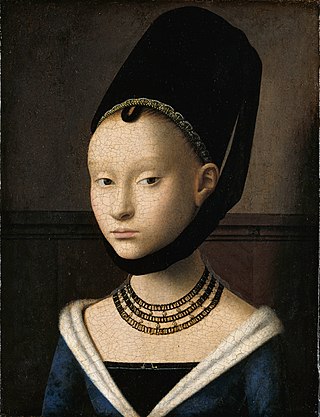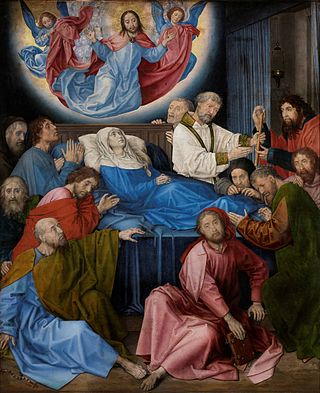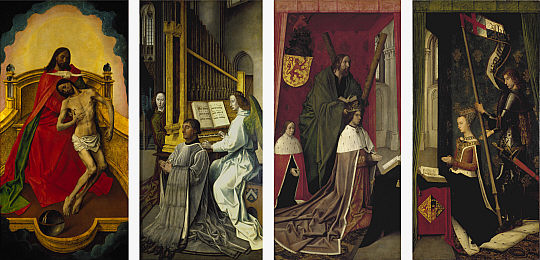Hans Memling was a German-Flemish painter who worked in the tradition of Early Netherlandish painting. Born in the Middle Rhine region, he probably spent his childhood in Mainz. During his apprenticeship as a painter he moved to the Netherlands and spent time in the Brussels workshop of Rogier van der Weyden. In 1465 he was made a citizen of Bruges, where he became one of the leading artists and the master of a large workshop. A tax document from 1480 lists him among the wealthiest citizens. Memling's religious works often incorporated donor portraits of the clergymen, aristocrats, and burghers who were his patrons. These portraits built upon the styles which Memling learned in his youth.

Robert Campin, now usually identified with the Master of Flémalle, was a master painter who, along with Jan van Eyck, initiated the development of Early Netherlandish painting, a key development in the early Northern Renaissance.

Bernard van Orley, also called Barend or Barent van Orley, Bernaert van Orley or Barend van Brussel, was a versatile Flemish artist and representative of Dutch and Flemish Renaissance painting, who was equally active as a designer of tapestries and, at the end of his life, stained glass. Although he never visited Italy, he belongs to the group of Italianizing Flemish painters called the Romanists, who were influenced by Italian Renaissance painting, in his case especially by Raphael.

Early Netherlandish painting is the body of work by artists active in the Burgundian and Habsburg Netherlands during the 15th- and 16th-century Northern Renaissance period, once known as the Flemish Primitives. It flourished especially in the cities of Bruges, Ghent, Mechelen, Leuven, Tournai and Brussels, all in present-day Belgium. The period begins approximately with Robert Campin and Jan van Eyck in the 1420s and lasts at least until the death of Gerard David in 1523, although many scholars extend it to the start of the Dutch Revolt in 1566 or 1568–Max J. Friedländer's acclaimed surveys run through Pieter Bruegel the Elder. Early Netherlandish painting coincides with the Early and High Italian Renaissance, but the early period is seen as an independent artistic evolution, separate from the Renaissance humanism that characterised developments in Italy. Beginning in the 1490s, as increasing numbers of Netherlandish and other Northern painters traveled to Italy, Renaissance ideals and painting styles were incorporated into northern painting. As a result, Early Netherlandish painters are often categorised as belonging to both the Northern Renaissance and the Late or International Gothic.

Hugo van der Goes was one of the most significant and original Flemish painters of the late 15th century. Van der Goes was an important painter of altarpieces as well as portraits. He introduced important innovations in painting through his monumental style, use of a specific colour range and individualistic manner of portraiture. From 1483 onwards, the presence of his masterpiece, the Portinari Triptych, in Florence played a role in the development of realism and the use of colour in Italian Renaissance art.

The Portinari Altarpiece or Portinari Triptych is an oil-on-wood triptych painting by the Flemish painter Hugo van der Goes, commissioned by Tommaso Portinari, representing the Adoration of the Shepherds. It measures 253 x 304 cm, and is now in the Galleria degli Uffizi in Florence, Italy. This altarpiece is filled with figures and religious symbols. Of all the late-fifteenth-century Flemish artworks, this painting is said to be the most studied.

Joos van Cleve was a leading painter active in Antwerp from his arrival there around 1511 until his death in 1540 or 1541. Within Dutch and Flemish Renaissance painting, he combines the traditional techniques of Early Netherlandish painting with influences of more contemporary Renaissance painting styles.

Portrait of a Young Girl is a small oil-on-oak panel painting by the Early Netherlandish painter Petrus Christus. It was completed towards the end of his life, between 1465 and 1470, and is held in the Gemäldegalerie, Berlin. It marks a major stylistic advance in contemporary portraiture; the girl is set in an airy, three-dimensional, realistic setting, and stares out at the viewer with a complicated expression that is reserved, yet intelligent and alert.

Michael Sittow, also known as Master Michiel, Michel Sittow, Michiel, Miguel, and several other variants, was a painter from Tallinn (Reval), Estonia who was trained in the tradition of Early Netherlandish painting. For most of his life, Sittow worked as a court portrait painter, for Isabella of Castile and her Habsburg relatives in Spain and the Netherlands, and other prominent royal houses. He is considered one of the most important Netherlandish painters of the era.

Trinity College Kirk was a royal collegiate church in Edinburgh, Scotland. The kirk and its adjacent almshouse, Trinity Hospital, were founded in 1460 by Mary of Gueldres in memory of her husband, King James II who had been killed at the siege of Roxburgh Castle that year. Queen Mary was interred in the church, until her coffin was moved to Holyrood Abbey in 1848.

A donor portrait or votive portrait is a portrait in a larger painting or other work showing the person who commissioned and paid for the image, or a member of his, or her, family. Donor portrait usually refers to the portrait or portraits of donors alone, as a section of a larger work, whereas votive portrait may often refer to a whole work of art intended as an ex-voto, including for example a Madonna, especially if the donor is very prominent. The terms are not used very consistently by art historians, as Angela Marisol Roberts points out, and may also be used for smaller religious subjects that were probably made to be retained by the commissioner rather than donated to a church.

The Hours of James IV of Scotland, Prayer book of James IV and Queen Margaret is an illuminated book of hours, produced in 1503 or later, probably in Ghent. It marks a highpoint of the late 15th century Ghent-Bruges school of illumination and is now in the Austrian National Library in Vienna. It is thought to have been a wedding gift from James IV of Scotland or another Scottish nobleman to James's wife Margaret Tudor on the occasion of their marriage, perhaps finishing a book already started for another purpose. A number of artists worked on the extensive programme of decoration, so that "the manuscript in its entirety presents a rather odd picture of heterogeneity". The best known miniature, a full-page portrait of James at prayer before an altar with an altarpiece of Christ and an altar frontal with James's coat-of-arms, gave his name to the Master of James IV of Scotland, who is now generally identified as Gerard Horenbout, court painter to Margaret of Austria; he did only one other miniature in the book. The equivalent image of Margaret is the only image by another artist, using a rather generic face for the queen's portrait, and in a similar style to that of the Master of the First Prayer Book of Maximilian. Other artists worked on the other miniatures, which include an unusual series of unpopulated landscapes in the calendar – perhaps the Flemish artists were not sure how Scots should be dressed.

The Death of the Virgin is an oil-on-oak-panel painting by the Flemish painter Hugo van der Goes. Completed c 1472–1480, it shows the Virgin Mary on her deathbed surrounded by the Twelve Apostles. The scene is borrowed from Jacobus de Voragine's thirteenth-century "Legenda aurea" which relates how the apostles were brought, at Mary's request, on clouds by angels to a house near Mount Zion to be with her in her final three days. On the third day Jesus appeared above her bed in a halo of light surrounded by angels to accept her soul at the point when his name was finally mentioned. Three days later he reappeared to accept her body.
Ian Lorne Campbell is a Scottish art historian and curator. Campbell was Beaumont Senior Research Curator at the National Gallery, London from 1996 to 2012, and from 1974 to 1996 lectured on the Northern Renaissance at the Courtauld Institute of Art, University of London. He has curated major exhibitions at the National Gallery and other museums, including ones on Rogier van der Weyden at Leuven in 2009 and the Prado in 2015.

Portrait painting in Scotland includes all forms of painted portraiture in Scotland, from its beginnings in the early sixteenth century until the present day. The origins of the tradition of portrait painting in Scotland are in the Renaissance, particularly through contacts with the Netherlands. The first portrait of a named person that survives is that of Archbishop William Elphinstone, probably painted by a Scottish artist using Flemish techniques around 1505. Around the same period Scottish monarchs turned to the recording of royal likenesses in panel portraits, painted in oils on wood. The tradition of royal portrait painting in Scotland was probably disrupted by the minorities and regencies it underwent for much of the sixteenth century. It began to flourish after the Reformation, with paintings of royal figures and nobles by Netherlands artists Hans Eworth, Arnold Bronckorst and Adrian Vanson. A specific type of Scottish picture from this era was the "vendetta portrait", designed to keep alive the memory of an atrocity. The Union of Crowns in 1603 removed a major source of artistic patronage in Scotland as James VI and his court moved to London. The result has been seen as a shift "from crown to castle", as the nobility and local lairds became the major sources of patronage.
Andrew Halyburton or Haliburton was a Scottish merchant.

Anselm Adornes, also known as Anselm Adorno, was a merchant, patron, politician and diplomat, who belonged to the fifth generation of the Adornes family to live in Bruges.

The Mystic Marriage of St. Catherine is a c. 1480 oil-on-oak painting by the Early Netherlandish painter Hans Memling, now in the Metropolitan Museum of Art, New York. The Virgin Mary sits on a throne in a garden holding the Child Jesus in her lap. Mother and child are flanked by angels playing musical instruments, with St Catherine of Alexandria to the left opposite St Barbara on the right. The male figure standing slightly behind the celestial group, presumably commissioned the painting as a devotional donor portrait.

Portrait of Maria Portinari is a small c. 1470–72 painting by Hans Memling in tempera and oil on oak panel. It portrays Maria Maddalena Baroncelli, about whom very little is known. She is about 14 years old, and depicted shortly before her wedding to the Italian banker, Tommaso Portinari. Maria is dressed in the height of late fifteenth-century fashion, with a long black hennin with a transparent veil and an elaborate jewel-studded necklace. Her headdress is similar and a necklace identical to those in her depiction in Hugo van der Goes's later Portinari Altarpiece, a painting that may have been partly based on Memling's portrait.

Meynnart Wewyck or Maynard Vewicke was a Netherlandish painter, active ca. 1502–1525 in England and Scotland, where he was known as "Maynard" and "Mynours". Wewyck was employed as an artist at the court of Henry VII of England and, after his death, by his son Henry VIII. He also spent a brief period at the court of James IV of Scotland. Surviving documentation associates Wewyck with portraits of several members of the royal family, and with drawings for the tomb of Lady Margaret Beaufort, mother of Henry VII, at Westminster Abbey. New research published in 2019 has identified a portrait of Lady Margaret Beaufort in the Master's Lodge at St John's College, Cambridge as by Wewyck, and also attributes a painting of Henry VII at the Society of Antiquaries of London to his hand. In follow-on work, a group of researchers suggests that four surviving portraits of Henry VIII and two of his mother, Elizabeth of York, should also be attributed to Wewyck.


















